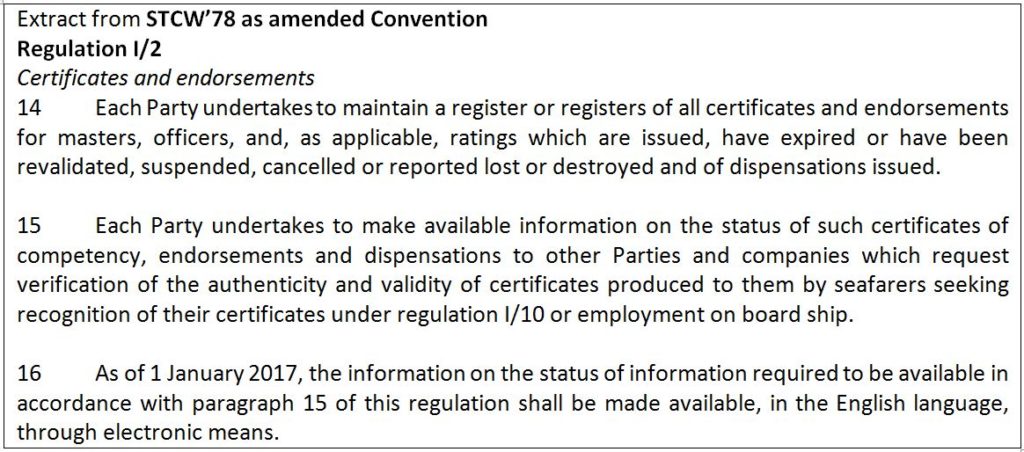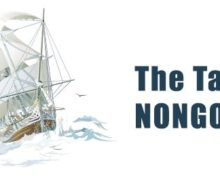![[নোঙর 2016] HARNESSING OF INFORMATION TECHNOLOGY (IT) IN SEAFARERS’ CERTIFICATION SYSTEM – SINGAPORE EXPERIENCE : Zulfiqur Husain (14)](http://bdmariners.org/wp-content/uploads/2016/06/MPA_QR-Code.jpg)
[নোঙর 2016] HARNESSING OF INFORMATION TECHNOLOGY (IT) IN SEAFARERS’ CERTIFICATION SYSTEM – SINGAPORE EXPERIENCE : Zulfiqur Husain (14)
Preamble: The Maritime and Port Authority of Singapore (MPA) was established on 2 Feb 1996, with the mission to develop Singapore as a premier global hub port and international maritime center (IMC), and to advance and safeguard Singapore’s strategic maritime interests. The MPA is the driving force behind Singapore’s port and maritime development, taking on the roles of port authority, port regulator, port planner, IMC champion and national sea transport representative. The MPA partners the industry and other agencies to enhance safety, security and environmental protection in Singapore port waters, facilitate port operations and growth, expand the cluster of maritime ancillary services, and to promote maritime R&D and manpower development.
In respect to the above, MPA is the prominent and competent organisation in Singapore, with respect to Port and Shipping regulatory matters. Singapore is a party to several International Maritime Organisation (IMO) Conventions and Protocols, and pursuant to the Standards of Training Certification and Watchkeeping for seafarers, 1978 (commonly known as STCW’78) Convention and Code; Singapore issues certificates of competency (COC) to the successful candidates upon meeting requirements of the Convention; and the National legislations namely, Merchant Shipping (Training Certification and Manning) regulations, and the Merchant Shipping Act (Maritime Labour Convention) regulations. With shipping routes constantly changing and emerging e.g. Polar route, new certification requirements are being introduced.
At present, MPA has two main types of pre-printed COCs to cater for the various classes of Deck Officers (DO) and Marine Engineer Officers (MEO), and these are further divided as per Capacity and limitations to about 60-70 different types of certificates and endorsements. The above certificate issuance process from receipt of an application, to the approval of a COC, revalidation requests, or responding to authenticity requests were undertaken via a manual process.
Aim: This paper aims to provide a brief description of MPA’s in-house developed web-based IT (Information Technology) program, which has enabled MPA maintaining an electronic database system of a seafarer’s certification in-line with meeting the amended STCW’78 international convention requirements.
Background of MPA’s IT certification: In 2000, leveraging on the versatility of IT’s data processing, storing, accessing or retrieval of information, MPA adopted a computerised Seafarers Certification System (SCS). The initial version was a simple storage of seafarers data, using the data the system will pull the relevant information and prints it onto the certificate booklet (i.e. instead of typing, on COCs using a typewriter; or cursive hand writing; on the COC). In the current version 3, most of the manual certificate issuance processes had been streamlined onto an e-form which is available online at MPA corporate website at www.mpa.gov.sg at e-services menu – hence allowing the submission of seafaring applications 24/7-basis, globally. This has improved the customer experience as submissions can now be undertaken without having to physically visit MPA to submit hard copies of applications, making cash payments, etc. The SCS facilitates MPA’s application processing, verifying of documents, application approval or rejection, and then issuance of a certificate or on-line authentication of certificates. MPA has recently adopted QRR (Quick Response Reader) imaging for checking of the authenticity of the certificates, using the mobile telecommunication devices; for further e-convenience of shipping community. Appended are the details of salient steps which were adopted by MPA:
a) Pre-joining medical fitness checks: All new entrants to the maritime seafaring profession must undergo a stringent pre-requisite medical fitness requirement/test and be certificated. The prescribed forms together with the fitness standards and guidelines are available at MPA corporate website.
b) E-application main menu: The applicants or their company personnel can submit an e-application via the MPA website and facilitate payments through the MPA Marinet Account or individuals’ electronic payment means. The SCS generates an e-application unique number automatically, and stores the data entered or attachments provided by the applicant (without the need for an MPA officer to prepare and allocate a prefix reference number, and manually filing all the photocopies provided. A screen shot of the main e-application menu is appended as below:
The guideline assists the applicant in completing the e-application (also the checklist in it ensures that all the ‘relevant supporting information and documents’ are readily available to improve the application submission process). The salient fields in the e-application include – Seafarer’s particulars, permanent/mailing addresses, contact detail, email address; Company particulars; Examination intent to take; Medical fitness certificate; Educational qualifications, ancillary courses, hands on workshop or lab training’s, e.g. Vocation training, examination transcripts, etc. The system allows scanned documents to be uploaded so as to reduce the need of resubmission. This also reduces the need for applicants to obtain an attestation or certified ‘as true copy of original’ for certificates which are photocopied.
c) Mandatory fields: There are mandatory fields are marked in red asterisks in the e-application and must be filled up before an application can be successfully submitted and a confirmation slip generated by the system. After examiner’s vetting, the status of the application can be viewed from the system, candidates would know if any additional supporting documents or clarifications’ is required.
d) Declaration by the applicants: The applicants are required to make a declaration towards the end of the application before ‘Submitting e-application’, mentioning that all documents submitted or attached belongs to the applicants and are ‘Correct and True’.
e) E-payments: The e-payments for application processing fee could be paid through the company’s Marinet Account or by individual customers through on-line methods such as via NET, or credit card.
f) E-application backroom processing stage: MPA support staff has to log-in the SCS portal as a means of identity and risk control – an audit log was incorporated to record staff access into the system and tracks a record of activities undertaken on the specific application. They Support officers after receipt of fees will commence the application processing.
g) Routing the e-application to the examiners: The support officers will thereafter route the e-application to the assigned examiner. The e-application can be easily identified via the date of e-application or other key fields e.g. names, passport number, etc, to mention a few.
h) Vetting of e-application by the examiner: The assigned examiner logs into the SCS and vets the e-application and approves the application, if all the relevant documents are submitted and are satisfactory; otherwise he flags it via a check-on prescribed box with a remark, if further details or additional documents are required. These remarks could be viewed by the applicants when he logs-in to check on their application status. The applicant, then provides further clarification or supporting information to facilitate the application process.
i) Letter of Eligibility: After examiner’s confirmation, the SCS generates a ‘Letter of Eligibility (LOE)’ or ‘Not-Eligible Letter’, and the system routes an e-mail to the applicant. A successful copy of the LOE is also sent to Singapore Maritime Academy (SMA-SP), for their resource planning, as they are the mainstream approved Training Service Provider in Singapore.
j) Attending of relevant preparatory and Ancillary courses: Using the LOE, the applicant will attend relevant preparatory courses and ancillary courses or make-good of the short fall of the requirements for that grade of certification. Instructions are given for applicants to check on the training providers planned/calendared schedules of courses and for them to book those courses directly. For countries with travel visa restrictions to enter Singapore, the applicants will be informed upfront in the LOE to obtain a student visa, and facilitate the purchase of foreign currency for paying of the tuition fees. We were also told that some of the foreign banks also gives students ‘Tuition loan’, – to facilitate youngster’s career development.
k) Examination / Assessment results uploading: The Training Service Providers (TSP) upon completion of the courses will send soft copies of the candidates’ written examination results, to MPA. This is to facilitate the booking of Simulator and oral examination at MPA (currently the MEO simulator assessments are conducted at SMA’s simulators).
l) E-Booking of oral examination: Currently, the booking of a candidate’s Simulator and Oral examinations are done manually, however the e-booking of simulator and oral examination is being developed and will be rolled out soon.
m) Examiner’s certificate: After passing the oral examination at MPA, the SCS is updated with all the qualifying requirements, such as the Simulator assessment, the Deck/Engineer oral examination results, medical fitness certificate and other relevant documents. Upon meeting all conditions the candidates will be issued with an appropriate COC and endorsements.
n) Capacity & limitation on the certificates: The examiner vets the whole approval process, and confirms the type of certificate to be awarded with appropriate rank, capacity and limitation.
o) Generating and E-COC issuance: The particulars of the successful candidate’s, are imported from the SCS database, and are printed using a specialised printer, on pre-printed COC booklet with the type of COC to be issued, the validity of the endorsement, limitation of the COCs, etc; including colour printing of seafarers photograph, DM’s digital signature, QRR image. The successful candidate put his signature on the COC as receipt of the COC and for its safe keeping.
p) Control measures: The e-certification system maintains a log of each log-in activities; for traceability and accountability, purposes. In addition, all printing of the COCs from the system will require 2 signatures – (i) MPA’s Director of Marine’s e-signature will be uploaded from the system, and (ii) supplemented by the signature of the examiner. This form of control mechanism would prevent indiscriminate or unauthorised access or manipulation to the computer’s certification system.
q) Replacement of a lost certificate: The issuance of a replacement certificate is easier from the SCS as compared to previously when information had to be manually searched through hardcopy archived files. For all request for a certificate to re-print, a supervisor approval is mandatory.
r) Compliance with International standards: The MPA certificates meet the International Convention requirements and the certificate’s content should ‘withstand the scrutiny’ by the foreign Port State Control officers’ and ultimately vessel detention could be prevented; or to pass the IMO auditor’s verifications.
s) Archiving of the e-COC and it supporting documents: The e-COC or Endorsement or other Certificate’s data and documents are archived electronically and a back-up system is maintained on the MPA server. A copy of the certificate is maintained in the SCS e-database, hence there is no need to maintain a separate hardcopy archive.
t) Revalidation or updating of Certificates: The revalidation of Certificates or Endorsement can also be done electronically by applying on-line and submitting the relevant certificates or documentary evidence of attaining those conditions. Upon meeting the qualifying conditions, a separate A4 size revalidation endorsement is issued to the candidate. This e-service facilitate applicant to be continued to be on board; in contrast to earlier practices when the original COC was required to be sent to MPA for revalidation (for extending the validity), – the seafarer could not be on board, as he don’t have the original COC on board the ship.
u) Authentication or verification request: Authentication request for checking the validity of certificates for seeking employment on board ship could be done using MPA website at link ‘authenticate seafarers certificate’; 24/7. The authentication request to check the validity of a certificate can also be obtained using QRR image from a mobile hand-phone device, on-the-go, at 24/7.
v) Security features on Certificates: The pre-printed COC booklets and A4 size endorsement certificate papers has adequate security features which prevents the unethical syndicates from forging of MPA COCs or certificates. Moreover, upon the detection of claimed-to-be-a-MPA certificate, which was acquired by fraudulent and dishonest means; has to undergo a swift and effective action by the justice department; hence there are no records of such forged MPA certificates, in recent years.
w) Generate reports: The Seafarers Certification System can generate various reports from the fields available in the system for statistic the purposes; to trend analysis.
x) Statistics Saving of space and environment: Using IT and virtually filing the seafarers certification files, the saving of shelf/room space could be achieved; – and the risk from deterioration (or degrading of) papers due to prolonged storage, or from fires; could be minimised if not eliminated. Using of less papers, which contributes in the saving of environment from cutting trees to produce papers and reduce CO2 emission during the paper production and other processes.
Conclusion: By leveraging on IT, MPA had better able to achieve advantages and streamline processes as part of continuous improvement. Manual processes were automated, face-to-face counter interactions were reduced, and the work processes were tracked and documented. At the same time, ensuring that these processes met the IMO STCW’78 as amended Regulations I/2 paragraphs 14-17 obligation, for Maritime and Port Authority of Singapore.
Extract from STCW’78 as amended Convention
Regulation I/2
Certificates and endorsements
14 Each Party undertakes to maintain a register or registers of all certificates and endorsements for masters, officers, and, as applicable, ratings which are issued, have expired or have been revalidated, suspended, cancelled or reported lost or destroyed and of dispensations issued.
15 Each Party undertakes to make available information on the status of such certificates of competency, endorsements and dispensations to other Parties and companies which request verification of the authenticity and validity of certificates produced to them by seafarers seeking recognition of their certificates under regulation I/10 or employment on board ship.
16 As of 1 January 2017, the information on the status of information required to be available in accordance with paragraph 15 of this regulation shall be made available, in the English language, through electronic means.
——————————————————–
Zulfiqur Husain, Senior Marine Surveyor, MPA
He joined the Maritime and Port Authority of Singapore (MPA) as an Investigation and Certification Officer in 2000. He was responsible for the investigation of incidents and accidents in Singapore waters and those involving Singapore-registered ships.
He sets standards for MEOs for Singapore seafarers Certifications and Recommend requirements to the management, for endorsement. He conducts oral exams, audits on training institutes whether they comply-with those set standards.
Foreign country Signing preparations for the Memorandum of Undertakings, pursuant to the STCW’78 Convention’s Regulation I/10 for seafarer certification recognitions matters. He also had attended IMO STW- Sub Committee meeting.
He also proposes standards for Singapore Bunker Surveyors, Bunker Cargo Officers, and Port Limit Engine Drivers trainings and examinations.
Mr. Husain holds MSc (Maritime Studies) from Nanyang Technological University, Singapore; in 2012. He obtained his Certificate of Competency Class 1 (Marine Engineering Officer) from the United Kingdom in 1986. He also hold MBA from University of Leicester, UK in 1994.
He joined Bangladesh Marine Academy in 14th batch as Engineering cadet in 1977. After a short stint in Bangladesh Shipping Corporation, he joined as 5th Engineer in NOL in 1982, before being promoted to Chief Engineer Officer in 1988 and left in 1992 for shore-job in GASINDO. Prior to joining MPA, he held positions Technical Superintendent, Operations Manager, VP Operations, in several maritime companies, including Mitsui OSK line (S) Pte/Navix Lines, and International Maritime Carrier (IMC).







![[নোঙর 2016] Message From the President](http://bdmariners.org/wp-content/uploads/2016/05/R-Qader_Message-220x180.jpg)


![[নোঙর 2016] আমার সেরা বিদেশ ভ্রমন : নাফিসা মাশহুরা ইরা](http://bdmariners.org/wp-content/uploads/2016/06/Dubai-city-tour-70x70.jpg)




Recent Comments